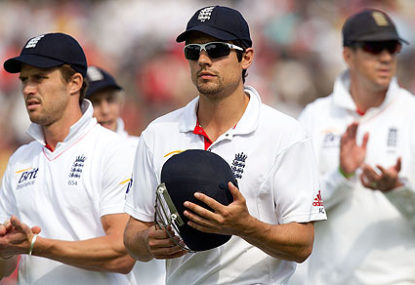Team of the Month: a May-born World Cricket XI
This series’ twelfth and final team has a distinct West Indian flavour at the top of the order, and a domineering captain.

England have proven that they are the real deal, silenced any doubters and given the Australians a harsh reality check in this Ashes series.
Few would dispute that the skill of the England players is superior to that of their Australian counterparts when assessed on an individual basis.
Only skipper Michael Clarke would be a walk up starter in this English outfit. Ryan Harris has done his best to address this significant imbalance.
The superior performance of the England players has helped hide some of the tactical frailties of their captain, Alastair Cook. Cook has been fortunate to inherit a settled England side at the peak of its powers.
Internal politics appear to be a thing of the past (in stark contrast to their opponents), and most of the players are in career best form. Apart from overseeing England’s come-from-behind victory against India earlier this year, Cook’s abilities as a captain and tactician have not yet been tested.
To give credit where it is due, Cook has used the DRS sensibly, sticking to a set procedure of consulting wicket-keeper and bowler and only seeking a review where there is a unanimous decision to do so. Cook is also an outstanding batsman with a temperament and hunger for runs which the current crop of Australian batsmen should be aspiring to emulate.
However, this author has been somewhat perplexed by the tactics employed by Cook during this series, particularly so at Durham.
Take Day four of the Durham Test for example. At 8 for no wicket, Stuart Broad, who “had the ball talking” for most of the match, produced a rare bad ball which was summarily dispatched by David Warner to the point boundary.
Cook’s reaction was to immediately employ a cover in substitution for an extra body in the slip cordon, in what can only be described as a negative move. It brought back memories of the tactics often employed by a recent Australian captain who will be better remembered for his batting prowess, rather than any particular tactical nous.
Durham was a new ball wicket where bowlers and slip fielders always felt in the game. The ball had a tendency to jag off a length, rather than being two paced and holding up on the surface. At Durham, field positions such as cover and mid-wicket are run saving positions, rather than realistic dismissal positions.
The author was further perplexed by the tactics adopted when Graeme Swann was bowling during the fourth innings. At one stage, there was a ring field on the on side when Swann was bowling to left handers, Warner and Khawaja. This can only be described in the nicest possible way as conservative.
On a turning wicket with inviting footmarks on a left-hander’s off-stump, I would have thought that leaving the leg side vacant and encouraging the batsmen to play against the turn through the gap would have heightened their chance of dismissal. In fact, Khawaja’s downfall in this series has been his tendency to play across the line to Swann, rather than with a straight bat.
Australia have not been out-maneuvered in a tactical sense, but have been unable to counter the skill and variety of the English attack. If Australia can begin to reduce the skill imbalance prior to the English touring down under, then the tactical frailties of the England captain may come to the fore.
Australia have superior “on-field” leadership. Michael Clarke has demonstrated during his reign in charge that he is a proactive captain who is not willing to let the game simply drift by.
Although some of Clarke’s decisions may be regarded as unorthodox at times, they are generally made with a wicket-taking, and not run-saving intention in mind. Despite the dominance of his bowling attack, the former does not currently appear to be at the forefront of the English skipper’s mind.